Is your beloved Pothos exhibiting yellowed and limp, soft parts even in the spring? Chances are that they are severely overwatered!
Similarly, crispy-looking Pothos leaves lacking rich green pigments may indicate an underwatered plant.
Both cases are alarming because Pothos quickly succumb to problems and may even die when not treated in time!
In general, it is ideal to water Pothos once a week in spring/summer with about an inch or 0.8 cups of water for a 5″ pot, and even lesser in fall/winter once in 2 to 3 weeks, but remember to check soil moisture for extra dryness beforehand.

This quick-growing vine can extend about 12 inches monthly and may quickly falter with improper watering.
Therefore, the proper watering schedule will do wonders for your Pothos plant when regularly monitored and measured.
Read on to learn everything about watering your Pothos plant with some improvement tips.
Table of Contents Show
How to Know When Pothos Needs Water?
The dry Pothos plants are too quick to exhibit signs of problems.
In the case of the Pothos plant, it will exhibit problems with the appearance and texture of the foliage and soil.
Here are a few tell-tale signs of a Pothos plant needing water.
1. Droopy Leaves and Brown Tips
Lack of watering will lead to excess transpiration of leaves, where the Pothos leaves will begin losing moisture.
The drying leaves will begin drooping under their weight, appearing limpy, whereas the top leaves are the first to droop as they are more likely to transpire.

Similarly, the dehydrated Pothos will lead to browning tips and blotches, which become more visible with time.
The tip will look dry and brownish, while the brown scars will appear as tiny dots around the leaf surface.
2. Dry, Light, and Cracked Soil
Dry and crumbled soil indicates that your Pothos plant may need water.
Once the soil moisture gets sucked up by the plant or evaporates into the air, the potting mix will turn light-colored.
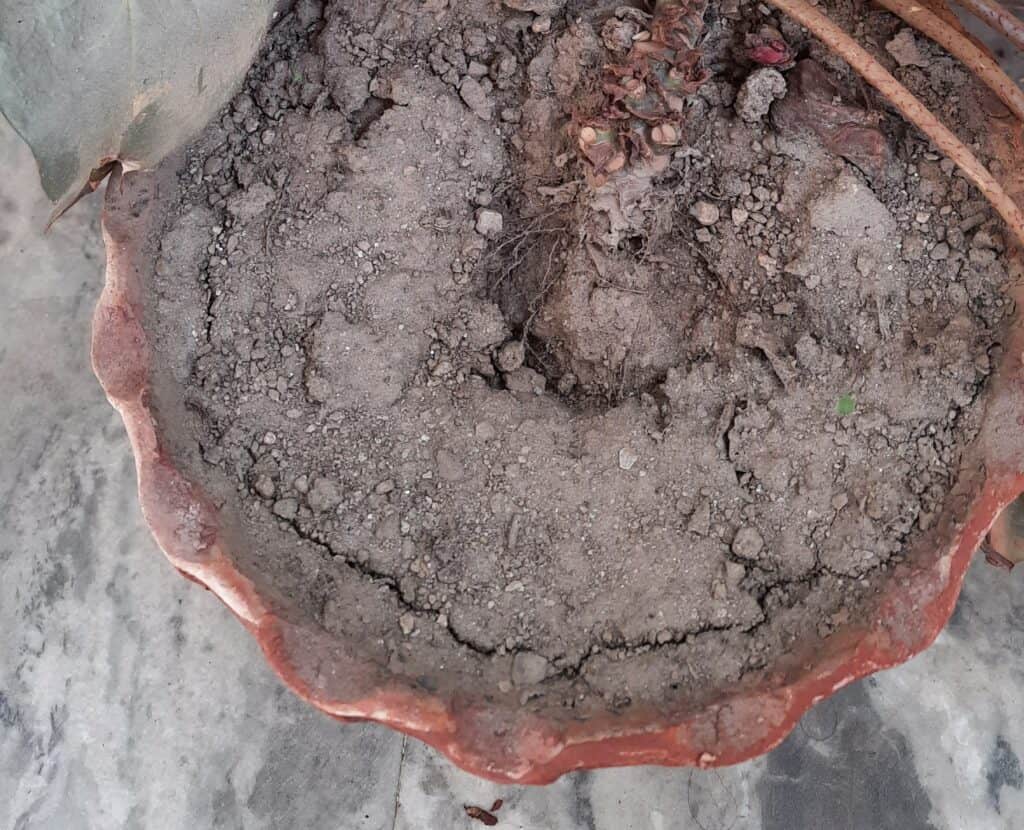
It will crumble to the touch and may even start to break due to soil compaction caused by severe drought.
You would not want this to happen, as the soil will begin losing moisture and nutrients to keep the plant roots looking healthy.
Note: The compacted soil is more likely to invite bacterial infections. Anaerobic bacteria thrive in compacted soils as oxygen levels are severely reduced.
3. Thinning and Crunchy Leaves
A severely underwatered Pothos will be exhibiting dry and crispy leaves.
However, the crispy leaf usually occurs when the soil gets bone dry, especially for extended periods.
Therefore, you should keep a tab on the watering schedule in summer when the temperature gets above 75°F.
The first signs are shown by lower leaves which turn brown and crispy.
Due to excess transpiration, the leaves will appear thin and paper-like, which would easily crumble to the touch.
The crispy texture would usually appear just at the leaves edges, which indicates a severely dehydrated plant.
4. The Pot Feels Light
One effective way to tell whether it is time to water your Pothos is to lift the pot to determine its weight.
Remember, water is heavy, and so is the recently watered pot; hence there is always a distinct difference between a wet and dry plant.
The dry plant is lighter than usual. This method will come in handy if you own a lot of potted plants.
For larger pots, 7 to 10 inches or more, try slightly tilting them to gauge their weight.
Make a habit of lifting the pot to determine its weight after watering, so you know how much it weighs.
Note: Succulents love drought conditions; hence they will usually feel lighter, but Pothos may not.
Signs you may be Overwatering your Pothos
Pothos grown as houseplants are more likely to experience overwatering due to gardeners’ tendency to overwater their plants.
Therefore, your Pothos is more likely to exhibit the signs of overwatering.
Two out of three times, the problems displayed by the Pothos plant are caused by overwatering.
Here are some tell-tale signs of an overwatered Pothos plant.
1. Soggy Soil
Soggy soil is the earliest and most visible sign of overwatering. You could tell it by looking at the soil that looks dark and mushy.
Another way to tell a soggy soil is to insert your finger into the potting mix, where it may feel mushy and sopping wet with water leaking out of the bottom.
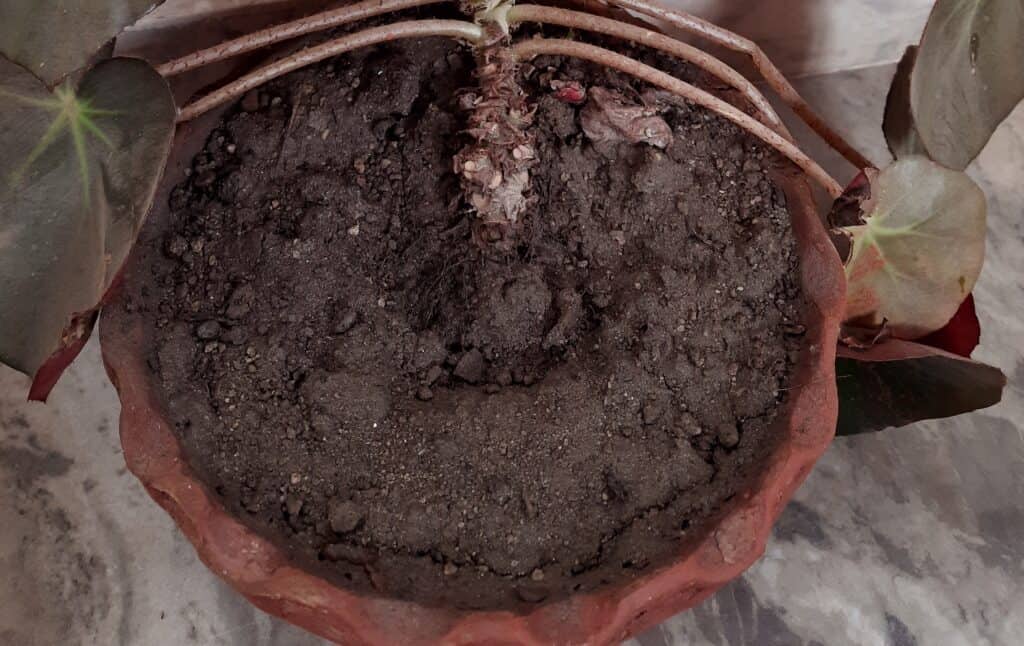
However, please do not confuse it with recently watered Pothos soil which will naturally feel soggy and wet.
Pothos pots severely overwatered will remain soggy for days and may even show signs of mold infestation.
2. Limping or Soften Leaves
Pothos suffering from “wet feet” are more likely to develop softer leaves and stems that bend under their weight.
The lack of oxygen and the waterlogged situation may push the roots into decay, leading to a weaker stem and leaf system.
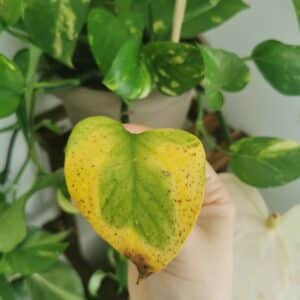
If you are confused about whether the issue is caused by over or underwatering, please check the soil moisture level.
The soil feeling drier and crumbled would indicate an underwatered plant.
3. Yellowing and Droopy Leaves
If your Pothos is exhibiting yellowing leaves, be assured that it is facing a water issue, either too much or too little.
However, yellowed foliage with some browning indicates an overwatered plant.
A color change in leaves is the first indication of an overwatered Pothos plant, where the leaf color will gradually change from green to yellow.

If the bottom older leaves start yellowing, the overwatering is the problem.
Frequent or excess watering and excessive foliar spray will all lead to soggy soil conditions, affecting the root’s ability to absorb nutrients and moisture.
They will suffocate and struggle to deliver water and nutrients to the leaves. Therefore, poor root health will extend to the lower stem and bottom leaves.
Note: Anaerobic conditions may also cause yellowing foliage but are limited to the issue of compact soil.
4. Brown Blotches on Leaves
Browning is typical with an overwatered Pothos, where the leaves would develop brown spots along with yellowing.
You would notice the brown blotches on the same leaf as the yellowing.
Although yellowing may indicate transpiration, brown patches at the leaf’s edge suggest that it is pushing too much water into the leaf, causing veins to burst open.

On the other hand, the browning of a portion or entire leaves may also indicate a bug or bacteria-infested plant.
It is more prevalent when you foliar spray the plant, leading to wet leaves that attract pests.
6. Wilting and Stunted Growth
The waterlogged Pothos will begin to wilt, and leaves will start to curl as they struggle to retain moisture.
The direction of curling may indicate the severity of the problem, whereas inward curl suggests it is getting more than usual watering.
On the other hand, wilting of the plant indicates a severely waterlogged plant, usually with root rot.
The damaged roots fail to transport oxygen to the plant stems, leading to excessive bending.
In addition, the Pothos will also stop growing as the roots fail to produce, leading to stunted growth.
7. Mold Growing on the Soil
The excessively wet soil is more likely to attract fungi, which leads to mold or mildew growth.
You would notice long, white, thread-like growth over the soil and lower stems, spreading further as the days go by.

Pothos grown in overly moist or cold places may also attract mold growth.
The fungi that cause mildew (Erysiphe, Microsphaera, Phyllactinia, Podosphaera, Uncinula, and Sphaerotheca) are biotrophic fungi that feed on living plant cells.
Mold growth on soil is a clear indication of overwatered and overly moist Pothos plant.
8. Fungal Root Rot
Rotting of healthy roots is expected when the plant is overwatered, caused by waterlogged soil.
Waterlogging helps breed fungi such as Pythium, Fusarium, and Phytophthora that affect the root system. As the rot spreads, the roots become mushy, brownish, or dark.
The soil’s lower stem rot, yellowing leaves, wilted appearance, browning leaves, and fishy smell indicate root rot.

If you are suspicious about your plant, consider uprooting it to monitor the root system.
Mushy, dark, and smelly roots indicate severe root rot. In fact, there is no going back from it.
Consider disposing of the plant or salvaging the remaining healthy root for transplant.
Read more about combating root rot in Pothos plants
The Best Watering Technique for Pothos
Pothos are perennial houseplants that thrive in warm temperatures with slightly moist soil and moderate humidity around the year.
However, ensure to water your plant properly because watering is one of the most important parts of Pothos care.
Inappropriate watering is the precursor to most problems in the Pothos plant.
Here are the best water techniques for the Pothos plant.
1. Conventional Watering
The conventional watering technique is the most common method of watering houseplants, where you directly pour water onto the soil.
You would generally take a mug or bowl, measure the water amount, and pour it all around the soil surface.
You should remember to water evenly on all sides when watering this way.
The roots are more likely to extend towards the water, leading to uneven growth of germs and a bent stem appearance.
Anyone with minimal gardening techniques can undertake this method.
However, avoid wetting the leaves as it can lead to moist foliage and chances of bacterial or pest infestation.
2. Saucer Method
The saucer method is also known as the bottom watering method, which prevents water from running down the sides of the pot.
Instead of soaking the soil, you would pour the water onto the saucer, which the soil will gradually take up.

Place a saucer underneath the pot and fill it with fresh, tepid water.
Let it soak for several hours and empty the saucer to avoid stagnant water from sitting idle.
Alternatively, fill a saucer with room-temperature water and mix water-soluble fertilizer to let the soil soak evenly.
3. Soaking Method
The soaking method is a standard watering method mostly tried with succulents to allow the soil to dry out between watering.
However, the soaking method is less likely to work with Pothos because they require water at regular intervals.
You should allow the top 2 to 3 inches of soil to dry out between watering, so the soaking method is a complete No-No.
Factors that Impact Watering Pothos
Many factors may influence Pothos’ watering needs, including some of these common factors.
1. Location (Indoor Vs. Outdoor)
Although indoor plants, Pothos can survive indoors and outside, provided temperatures do not exceed 90°F (32°C) for longer.
Due to the excessive sunlight, heat, and less humidity, the outdoor grown Pothos will require watering more frequently.
Here is a golden rule for watering Pothos -“Water more often in brighter light and lesser in lower light.”
Water your indoor Pothos every one to two weeks in spring and summer and every two weeks in winter, allowing the soil to dry out between watering slightly.
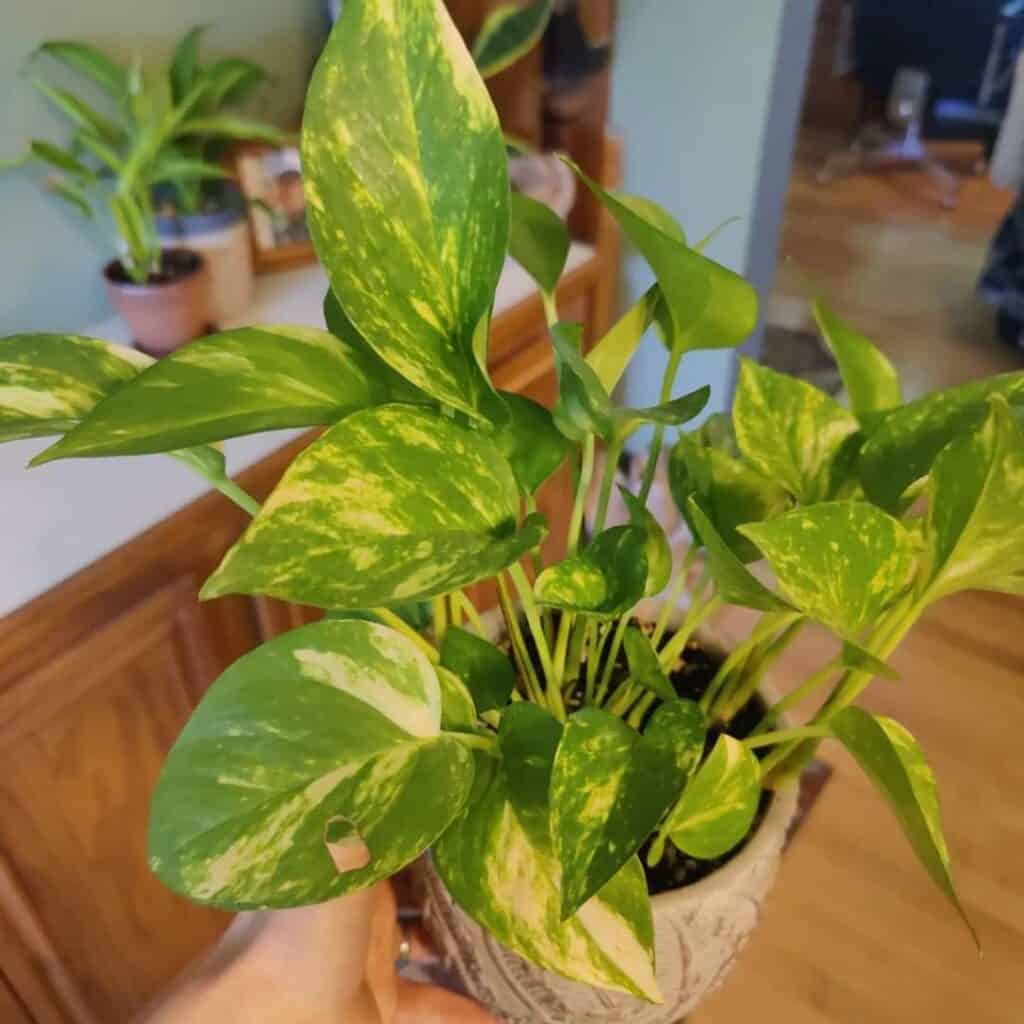
You can assess the soil moisture using a moisture meter to determine whether the top few inches of soil have dried out.
On sunny days, the soil will dry out quickly, requiring frequent watering, but winter brings in dormancy, requiring less frequent watering.
For outdoor grown Pothos, consider watering every 4-5 days in summer and once every 2-3 weeks in winter.
2. Well-drained Potting Mix
Pothos prefers a well-drained, light soil mix containing peat moss, coco coir, perlite, and sometimes vermiculite.
This potting soil contains organic and inorganic matter that does not retain excess water and dries out fairly quickly.
Therefore, watering weekly would suffice to keep the soil mix slightly moist.
However, regular potting soil with the sandy mix usually found outdoors will retain more water.
The best solution is to avoid growing Pothos in a heavier potting mix, as it retains more moisture and slows down root growth.
Read more about best potting mix and fertilizer for Pothos
3. The Type of Pot
Almost any container type works for Pothos as long as it has at least one drainage hole.
When growing Pothos in a plastic container, remember to use a pot with multiple drainage holes to allow the soil to drain out quickly.
Be mindful about overwatering Pothos grown in a plastic planter, as it can retain excess moisture.
Compared to plastic, clay and ceramic pots are more likely to allow the soil to exert excess moisture.
Hence, they work perfectly for water-loving plants like Pothos.
4. Type of Water
Watering houseplants like Pothos requires chlorine-free water that is easy to absorb by the roots.
Excess chlorine water buildup can lead to mineral residue in the soil, making it more compact.
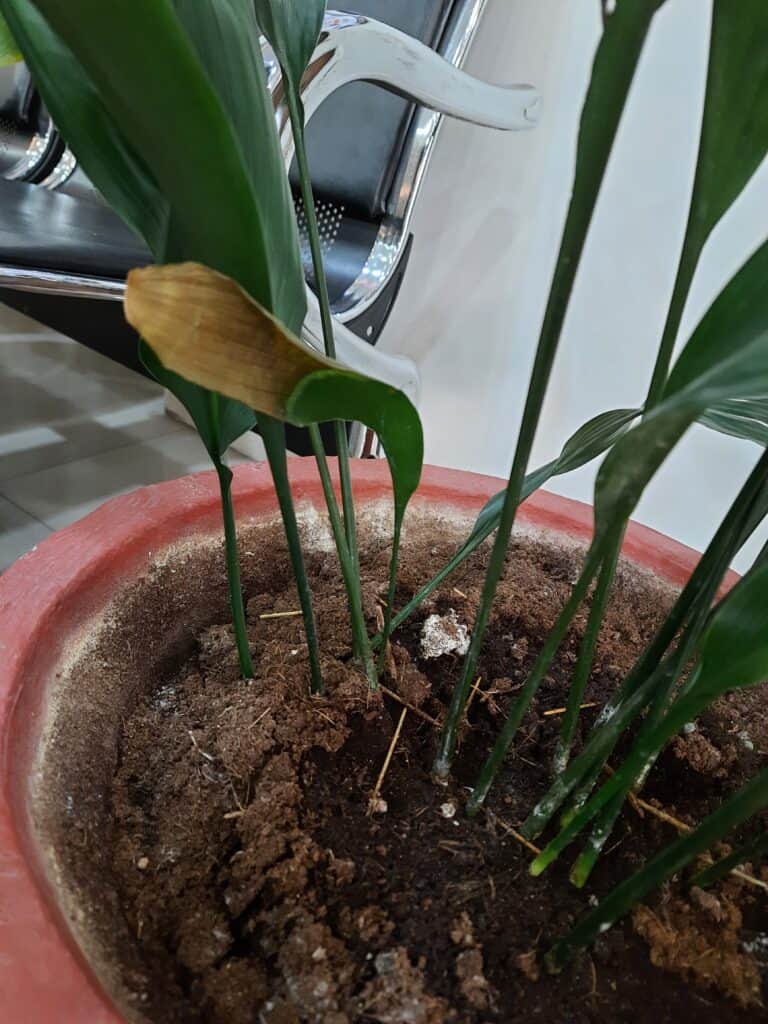
Compact soil is less likely to retain or drain water, leading to bacterial infection.
On the other hand, soft water contains more sodium, leading to salt buildup. Therefore, always use tepid, chlorine-free tap water or rainwater for Pothos.
5. Temperature and Humidity
Pothos grows best at 70 to 90°F temperature and humidity level of around 60%, requiring watering once a week.
However, the temperature or humidity level may not always be ideal.
You can slightly increase the watering amount in summer when the temperature reaches above 90°F, and the humidity level drops below 40%.
Consider watering only when the top few inches of soil dry out for the indoor-grown plant in ample humidity and cool temperature.

How Often to Water Pothos?
Pothos is a water-loving plant, but it does not mean it loves sitting in a pool of water.
If you are a newbie gardener, consider following the Pothos watering schedule to avoid the risk of overwatering.
As per the rule of thumb, water your Pothos every one to two weeks to allow the soil to dry out between watering moderately.
Provide an inch or 0.8 cups of water to a 5″ Pothos pot.
Remember, you should know your plant needs immediate watering when the foliage begins to wilt.
Similarly, reduce watering in fall and winter when the temperature drops below 40°F and the plant goes into dormancy.
Should you Mist the Pothos?
Pothos does not generally require misting but can benefit from frequent misting in summer.
Summer often brings more dusty conditions and heat, which may affect Pothos leaves’ ability to produce Chlorophyll.
Therefore, misting a few times a week with a plant mister or washing the leaves with clean water will help the foliage look healthy.
However, avoid misting the plant kept in dark and moist conditions, as it may invite pests and diseases.
Conclusion
Newbie gardeners trying to grow Pothos for the first time should keep watering, soil, temperature, and humidity in check.
Pothos enjoy frequent watering, but they hate sitting in waterlogged soil. Moreover, they are more likely to be overwatered, resulting in root rot and other problems.
Therefore, follow this guide to keep your Pothos watering in check.
Related Article: How to Save an Overwatered Pothos?


